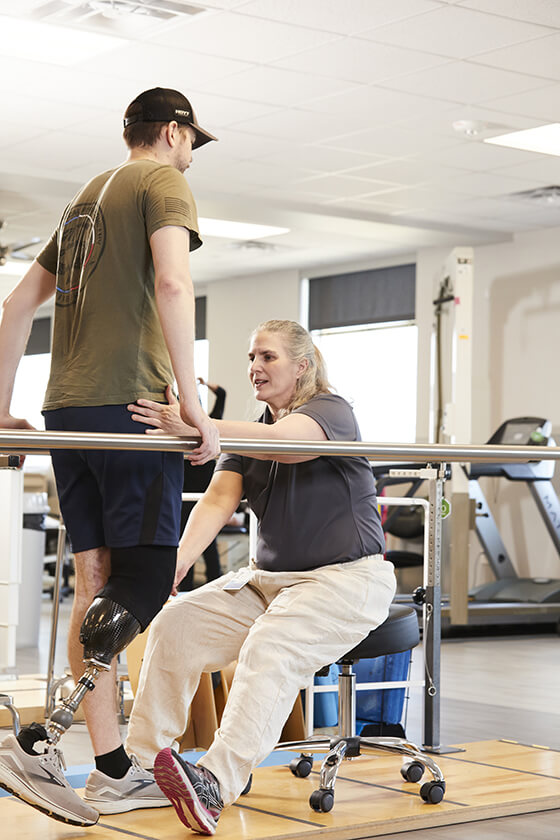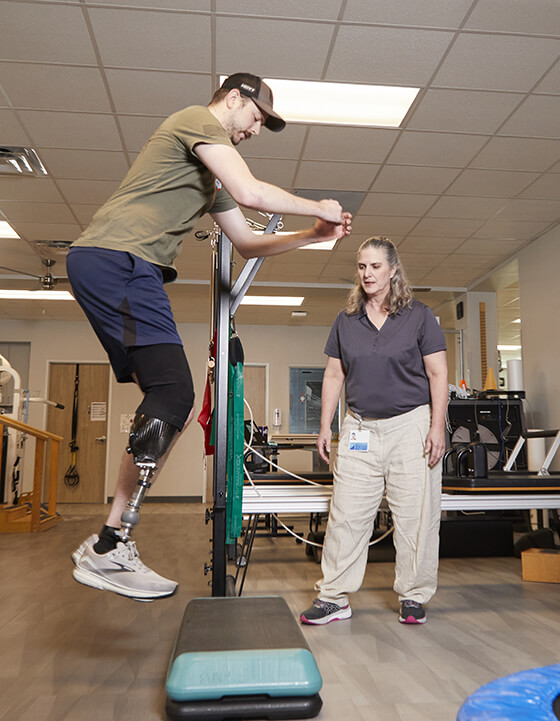The landscape of limb loss
A multidisciplinary approach to an amputee’s journey
Posted 4/29/2024
Losing a limb is a profound and life-altering experience that for many can extend beyond the physical realm. Whether medically planned or accidental, the realization of limb loss is traumatic, often accompanied by strong emotions, chief among them shock, despair and disbelief.
The sudden comprehension that a part of oneself is gone forever can be overwhelming, leaving amputees grappling with a sense of loss and uncertainty about the future.
Grief is also a common companion, as individuals mourn not only the physical loss but also the dreams and aspirations that may now seem out of reach.
However, this small yet mighty community often have stories that go untold, and their journeys are all unique as they navigate the highs and lows of their experience, showing resilience along the way.
This resilience defines the amputee experience.
Upper extremity limb loss
What does upper extremity mean?
The upper extremity is the region of the body that includes the arm, forearm, wrist and hand.
Upper extremity amputations are usually done for a variety of circumstances, including:
- Infections
- Trauma to the area (landscaping injury, work injury, etc.)
- Cancer
- Disease progression
- Genetic malformations
Those who lose a finger may still have full function of their hand, but those who require an amputation above their elbow (trans humeral), below their elbow (trans radial), to their shoulder or lose more than one finger will typically have less functionality.
They will never get that limb back, and learning how to live their life in a new way can be challenging.
So, what happens next?
When an upper extremity amputee patient first arrives, an occupational therapist will evaluate options for the span of treatment and gather information about the goals the patient wants to achieve.
Goals can range from wanting to throw a baseball again or being able to pick up a child. Patients may express they simply want to feel as “normal” as possible. As goals vary, customized therapy sessions are designed for all amputee patients.
Exercises for upper extremity amputee patients
Occupational therapy plays a crucial role in an amputees’ journey by providing specialized treatment sessions tailored to help them regain function, independence and confidence in their daily lives. The goal is to have amputee patients learn their fine motor skills again with their new prosthetic.
An important component of occupational therapy for upper extremity amputees involves specific exercises designed to enhance strength, mobility and coordination following the fitting of their prosthetic limb.
These exercises may include:
- Mirror therapy – Using a mirror to visualize and simulate movements of the intact limb, helping retrain the brain and improve coordination. The brain is tricked into thinking that the amputated limb can function just as well as the other side. This can also help decrease phantom limb.
- Targeted activities – Engaging in functional tasks such as pouring, grasping objects of various sizes, self-care tasks, work-related tasks and manipulating tools and utensils to improve hand-eye coordination. These targeted activities are usually personalized by the therapist to fit an amputees’ lifestyle.
- Biofeedback exercises – Biofeedback gives the therapist real-time information about physiological functions—such as the heart rate. The three most used forms of biofeedback therapy are: Electromyography (EMG), which measures muscle tension; thermal biofeedback, which measures skin temperature; and neurofeedback, which evaluates brain activity. This critical information can be used to ensure that the patient is getting the maximum capability out of their new prosthetic.
- Desensitization exercises – An occupational therapist can look at a patient’s face and tell that their prosthetic or orthotic is physically uncomfortable. Post-amputation the residual limb is often hypersensitive when rubbed against the material or texture of the prosthetic. Sometimes it is the amount of pressure being put on the area. The occupational therapist can adjust as needed and communicate with the prosthetic company about the necessary improvements for fit.
Throughout therapy, an occupational therapist will continue to evaluate how the prosthetic is helping the patient.
Lower extremity limb loss
The lower extremity refers to the region of the body comprising of the legs, from the hips to the feet. It includes the pelvis, thighs, knees, lower legs (shins), ankles and feet.
Lower extremity amputations are usually done for a variety of circumstances, including:
- Infections
- Car or work accident
- Vascular disease
- Diabetes
- Cancer
- Disease progression
Alongside medical interventions and prosthetic fittings, physical therapy emerges as a cornerstone of rehabilitation, guiding patients through the process of healing, adaption and reclaiming mobility.
One of the primary goals following lower extremity amputations is to restore mobility and function.
Exercises for lower extremity amputee patients
Physical therapists employ a variety of techniques and modalities, such as:
- Pre-rehabilitation – Shaping of the residual limb with a deep tissue or retrograde massage and addressing any post-operative complications such as swelling or pain.
- Prosthetic training – Doing weight bearing and weight shifting with parallel bars to improve gait and balance with the new prosthetic or orthotic.
- Gait and posture – Studying the patient’s posture while standing with their new prosthetic and observing walking patterns.
- Addressing functional limitations – Relearning how to move and shift is crucial, from climbing stairs to getting in and out of chairs to standing for extended periods.
It’s not just about the physical recovery, though. It’s also about fostering long-term wellness and quality of life.
As patients progress in their rehabilitation journey, physical therapists provide ongoing support and guidance to help them achieve their goals and maintain optimal function.
Like all patients, amputee patients thrive on knowing how they’re progressing throughout the rehabilitation period, and physical therapists will stay by their side, a true partner in their recovery journey.
Two sides make a team
You might be wondering who collaborates and how they support amputee patients. You're probably curious about the entire process—from amputation to achieving full function with the prosthetic or orthotic.
Indeed, it requires frequent communication and teamwork between occupational and physical therapists as well as the prosthetics and orthotics team to develop the individualized care that advances physical recovery and helps patients overcome the many emotional, psychological and social challenges that surface.
Here’s how the process works:
- After surgery/before prosthetic: After an initial evaluation, the occupational and/or physical therapist will look at the swelling around the area of trauma to determine pressure points, nerve pain or areas of tenderness. The therapist will do a shaping of the residual limb by a retrograde massage, elevation, cold modality or a deep tissue massage around the wound. This will help reduce swelling and remodel scar tissue before the initial fitting for their prosthetic or orthotic. A determination will be made if the patient is a candidate for a prosthesis, and if they are, they will be educated on next steps. The therapist will then communicate with the prosthetic team and practitioners, the nurse case manager, the patient’s family and caregivers.
- Offering emotional support/additional resources: Occupational and physical therapists are sensitive about a patient’s emotional space and often discussions are held at a more personal level. Of course, a referral can be made to a psychologist for the patient if they wish to speak to someone further about their emotions or all the changes they’re enduring, as well as to other resources as they navigate their new health care landscape.
Amputee patients will then work with a prosthetics company to get fitted for their prosthetic.
- Two to six weeks after amputation: The prosthetics team will spend some time getting to know the patient, like what their hobbies are and what they do for work. The patient will also be fit with a shrinker that goes over the amputated site to help with swelling. A test socket will be made with a mold from the limb or a digital scan. The team will take this model and use that to fabricate a plastic test socket.
- Building the prosthetic: The patient is then back at occupational or physical therapy. After practice with the test socket during therapy, the notes taken by the therapist about how comfortable the patient is and how they are doing with exercises are communicated back to the prosthetic team so that a final, fine-tuned prosthetic can be made.
- Physical/occupational therapy: The patient will continue to use their prosthesis throughout their therapy sessions and exercises to work on balance, gait and other daily activities such as eating, feeding, bathing or using the bathroom. Final tweaks and check-ups toward the end of treatment ensure a smooth transition back into everyday life with the customized prosthetic.
- A partner for life: The prosthetic and orthotic team is committed to helping the patient get where they want to go – now and as their needs change over time. From product tune-ups to upgrades, they are your lifetime partner.
It’s all one, large collaboration on behalf of the amputee patient. Occupational therapists and physical therapists work together with the prosthetics and orthotics team, who work with hospitals, manufacturers, vascular doctors, case managers and more.
This synergetic team is committed to working collaboratively with amputee patients to understand their unique situation and develop a customized plan of care that propels them toward their everyday activities.
All of them have one mission: To help the patient find their sense of normal again and be comfortable and confident with their new way of life.



